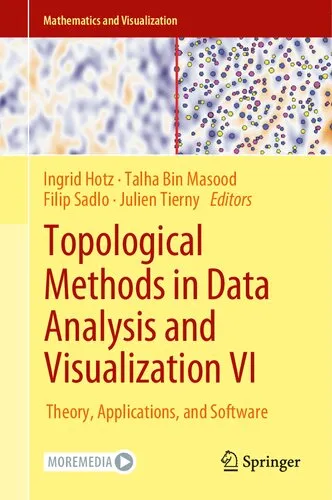Topological Methods in Data Analysis and Visualization II: Theory, Algorithms, and Applications
4.4
Reviews from our users

You Can Ask your questions from this book's AI after Login
Each download or ask from book AI costs 2 points. To earn more free points, please visit the Points Guide Page and complete some valuable actions.Introduction to "Topological Methods in Data Analysis and Visualization II"
The book "Topological Methods in Data Analysis and Visualization II: Theory, Algorithms, and Applications" is an essential resource for researchers, practitioners, and students seeking to explore cutting-edge developments in topology-driven data analysis and visualization techniques. Edited by Ronald Peikert, Helwig Hauser, Hamish Carr, and Raphael Fuchs, this second volume in the series builds upon the foundations established in its predecessor and dives deeper into theoretical advancements, algorithmic innovations, and diverse applications of topological methods.
In today's data-driven world, making sense of complex datasets is a growing challenge for professionals and researchers across multiple domains. This book captures the essence of topological data analysis (TDA) and visualization—a field that has emerged as a robust framework for exploring the structure of data in ways that are reliable, comprehensive, and visually intuitive. The contributions included here come from experts with diverse backgrounds in computational geometry, data visualization, mathematics, and more. Together, they provide a multi-disciplinary perspective to a thriving field.
This comprehensive book addresses both the "why" and the "how" of topological methods, thereby appealing to a broad spectrum of readers. The integration of theoretical insights with practical, real-world applications ensures its utility as both a scholarly reference and a hands-on guide.
Summary of the Book
The book is organized around several key themes, reflecting the diverse scope of topological data analysis and visualization:
- Theoretical foundations of TDA: Detailed exploration of the mathematical underpinnings of topology and its role in data analysis.
- Algorithmic breakthroughs: A focus on computational methods, including their development and optimization for analyzing massive datasets.
- Applications in diverse domains: Case studies from scientific visualization, engineering, finance, social sciences, and more, portraying practical implementations of TDA.
Each chapter highlights the interplay between theory, algorithmic development, and application, showing readers how abstract principles translate into tools and methods that benefit real-world problems. The discussions are enriched by a wealth of examples, diagrams, and detailed algorithmic descriptions, enabling readers to dive deep into the subject matter while gaining actionable insights.
Key Takeaways
The book offers numerous takeaways, including but not limited to:
- A comprehensive understanding of topological techniques such as persistence homology, Morse theory, and Reeb graphs.
- Insights into state-of-the-art algorithms for processing data with a topological focus.
- Use cases in diverse fields, demonstrating how TDA can provide unique and groundbreaking insights.
- Tools for integrating topological visualization methods into your own research or professional projects.
- A balanced emphasis on both the theoretical aspects and their practical implementations.
By the end of this book, readers will not only have a deep understanding of topological methods but also the confidence to apply these techniques to solve challenging data-intensive problems.
Famous Quotes from the Book
"Topological data analysis marks a paradigm shift in how we reason about, interpret, and visualize complex data structures."
"Through the lens of topology, even the most unstructured, noisy datasets reveal patterns, trends, and underlying order."
"Visualization is not only about aesthetics but about revealing the essence of data. Topological methods achieve this elegance and clarity in unparalleled ways."
Why This Book Matters
In an era of big data and increasing complexity, traditional analysis and visualization methods are often insufficient to uncover the hidden structures that define datasets. Topological methods fill this gap by offering a framework that is not only mathematically robust but also highly practical.
As the second volume in a groundbreaking series, this book pushes the boundaries of what is possible with topological techniques. By fostering a synergy between theoretical advancements and practical applications, it helps bridge the gap between academia and industry. Whether you're a seasoned researcher, a curious student, or a data professional looking to adopt cutting-edge methodologies, this book provides something valuable for everyone.
In addition to its scholarly importance, the book's emphasis on algorithms and applications makes it a vital resource for developing new tools and techniques for topological data analysis and visualization. As fields like bioinformatics, machine learning, and computational fluid dynamics continue to grow, the relevance of such resources will only increase.
In summary, "Topological Methods in Data Analysis and Visualization II" represents a crucial step forward in the field of data science, bringing clarity, intuition, and concrete solutions to the most pressing challenges in data analysis and visualization.
Free Direct Download
Get Free Access to Download this and other Thousands of Books (Join Now)
For read this book you need PDF Reader Software like Foxit Reader


